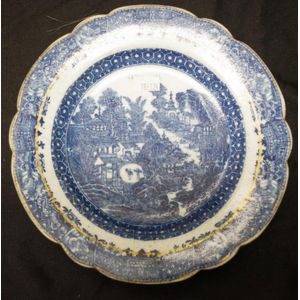18th c. Chinoiserie Plate with Back Chip
English 18th c. blue and white soft paste plate with chinoiserie decoration, diameter 20.5 cm, small back chip
You must be a subscriber, and be logged in to view price and dealer details.
Subscribe Now to view actual auction price for this item
When you subscribe, you have the option of setting the currency in which to display prices to $Au, $US, $NZ or Stg.
This item has been sold, and the description, image and price are for reference purposes only.
- Chinoiserie - Furniture and decorative items decorated in imitation of a Western interpretation of the Chinese style. The Chinoiserie style first became popular in the late 17th century, though there were frequent revivals, notably by Chippendale (hence 'Chinese Chippendale') during the Regency period, and the Anglo-Japanese style in the second half of the 19th century.
The ubiquitous 'willow pattern' is the most common 'Chinese' theme used in porcelain, while on furniture the Chinoiserie style usually has black or red painted and lacquered decoration, though the hallmark of the furniture style is the use of fretwork in geometrical patterns, pagodas and other decorative forms.
Japonaiseries, as the name implies, are motifs in imitation of the Japanese taste.
See also "Chinese Chippendale". - Soft Paste Porcelain - Porcelain is an ancient ceramic material, first made in China, hence the common name "china", and the process was unknown in the West.
European potters attempted to replicate Chinese porcelain, without knowing the ingredients in its composition, and the earliest wares were produced with mixtures of clay and ground-up glass (frit), the idea being that the glass would give the porcelain translucency.
It was given the name "soft" because it did not remain rigid, but "slumped" when fired in the kiln at high temperatures.
This item has been included into following indexes:
